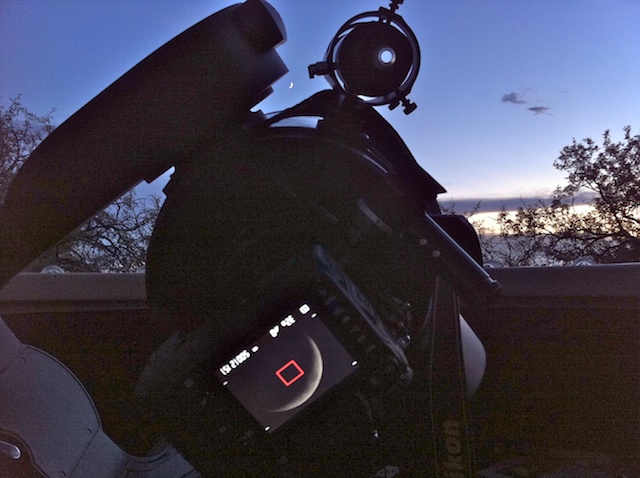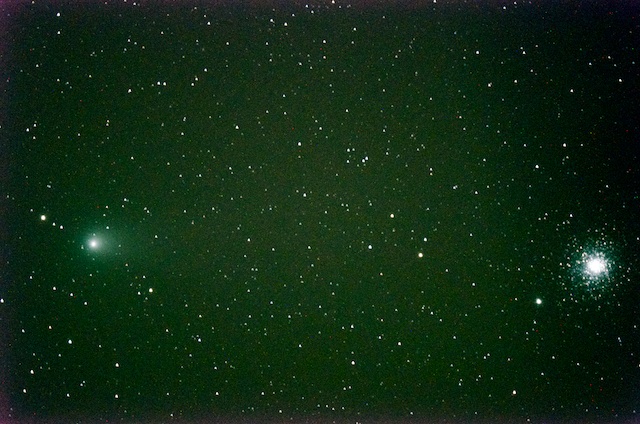
Moon, M63, Comet Garradd & M15, Lightning
Last updated: 3 August 2011![[Home!]](../../../../../etx/images/mighty_etx_logo_orig-sm.jpg)
 |
Moon, M63, Comet Garradd & M15, LightningLast updated: 3 August 2011 |
![[Home!]](../../../../../etx/images/mighty_etx_logo_orig-sm.jpg) |
| Follow @mweasner | Welcome | Photos | Videos | Equipment | Links | Data |
After the morning session on Tuesday, 2 August, to observe the sun, cumulus clouds appeared, threatening the clear sky forecast for the evening. As sunset approached, I decided to open the observatory anyway as I was hoping to image M63, the Sunflower Galaxy, before it got too low in the sky, and I also hoped to image Comet C/2009 P1 Garradd near the M15 globular cluster. I opened the observatory at 1910 MST, 97°F, under partly cloudy skies. Here is the crescent moon and clouds, Nikon D7000 DSLR, f/5.6, 1/400sec, 300mm, ISO 500:

I took a quick look at the moon in the 8" at 77X. At sunset, I took these photos of monsoon storm clouds to the south (top) and north (bottom) with the iPhone 4:


These storms, along with others, would be a nuisance all night long.
I captured this image of the moon at prime focus + Off-Axis Guider (OAG) on the 8" with the D7000, 1/250sec, ISO 500:

Using the iPhone 4, I captured this photo of the crescent moon (between the LX200-ACF fork arm and finderscope) and as seen on the D7000 DSLR display:

At 2000 MST, I slewed the telescope to M63, the Sunflower Galaxy and began waiting for the sky to darken, and hopefully for the clouds to go away. The sky was being lit up by lightning from the storms to the northeast and south. But the hilltop light was off. It really makes a difference in the darkness at my site when the light is off. Many thanks to the neighbors for continuing to leave it off at night. At 2020 MST, I took a framing test image; M63 was not well centered. I decided to SYNC the AutoStar II on Mizar and then slewed back to M63. Thin clouds were now hampering the imaging, but I took some more framing test images and finally captured this image at prime focus + Off-Axis Guider, 2 minutes, unguided, ISO 6400:

There was just too much cloud cover and more lightning to the southwest, west, and northeast, to look for a guide star and try for longer exposures. So, I gave up on M63 for the night.
At 2103 MST, SYNCed on Altair, and then went to M15, globular cluster. I took a quick image of M15 to check the focus. It was good. I went to the Heavens-Above web site and got the current RA/Dec for Comet C/2009 P1 Garradd. Slewed to the coordinates and took a quick image. It was too far away from M15 to get both in the same FOV. Clouds were approaching the portion of the sky I was imaging so I quickly added the focal reducer. Did a focus test on Altair using the Bahtinov Mask, and then slewed back to the comet. I could easily see M15 in the viewfinder and a bright star near the comet, so I was easily able to frame both in the same FOV. Thin clouds were now over the comet and globular cluster and lightning was very frequent, lighting up the entire sky. But I did imaging anyway. I took 1, 2, 3, and 4 minute, unguided, exposures at prime focus + focal reducer + OAG, ISO 6400. The 3 minute exposure was the best:

I ended imaging at 2141 MST due to the clouds and lightning. Viewed the comet and M15 in 7x50 binoculars; both were small faint fuzzies. Then viewed both in the same FOV in the 8" with 26mm eyepiece + focal reducer; very pretty. I removed the focal reducer and viewed the comet at 77X; the coma was about the size of M15, with a faint diffuse tail just barely visible through the thin clouds.
I had planned to image Comet 45P Honda-Mrkos-Pajdusakova this night as well but the cloud cover was too thick at its position. In fact, by 2207 MST, the sky was mostly overcast, with lots of frequent lighting in the distance in most directions. Decided to close up for the night. It was great to back in the observatory at night after almost three weeks of no observing due to monsoon pattern clouds and storms.
Closed the observatory at 2220 MST, 83°F.
The storms finally arrived in Oracle at about 0100 MST, with heavy rain (0.22" in 30 minutes) and lots of frequent lightning and thunder. The local electrical company turned off the power during the storm. I took a video of some lightning to the west using the iPhone 4. Here are two frames from that video:


Go to the previous report.
Return to the Cassiopeia Observatory Welcome Page.